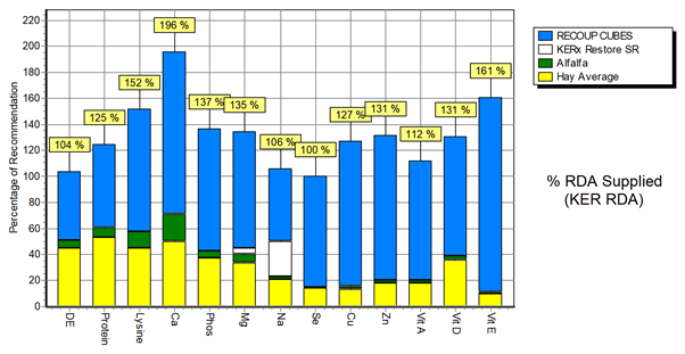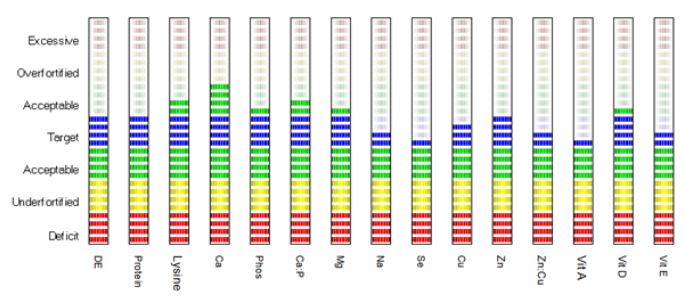Horses in Training – Early Fitness
Microsteed analyses the nutrient contribution from all feeds, roughages and supplements against set nutrient requirements. For horses in the early stages of training, Microsteed helps to identify changing nutrients needs against changes in workload. With a convenient and easy to understand assessment of energy contribution, Microsteed is a valuable tool when starting into early fitness work.
This example shows a horse returning to training in the early weeks fed 4 kg of Recoup Cubes, alfalfa, typical hay and electrolytes. Microsteed can be adjusted against the frame of the horse to show calorie requirements to build condition or assist with weight loss, if returning to work carrying excess weight, whilst ensuring all core nutrient requirements are still met.
Daily intake of nutrients

The inclusion of alfalfa alongside hay with a good calcium profile raises calcium intake above the level for requirement, however, such an intake is not harmful, and may be beneficial, particularly as alfalfa is known for its positive effects on stomach health. Through analysis comparing total intake against optimum ranges, it is possible to see that calcium intake is still within normal range.
Microsteed is an important tool when deciding where supplements are needed and when they should be avoided through providing information on the total dietary balance.
Optimum nutrient ranges

In addition to considering total daily intake, Microsteed will also consider the balance of key minerals in the total diet including calcium, phosphorus, zinc and copper. The balance of minerals influences absorption and also activity within the body.
Mineral Ratios

Once nutrient intake and balance is considered, Microsteed also assesses the contribution nutrients make toward energy requirements. The balance of energy provided through the various nutrients is important when considering impact on type of energy provided, fast releasing or slow releasing, and how this fits against style of training and temperament of the horse. Energy balance is particularly important when feeding horses prone to tying-up.
In contrast to the example diet for a horse in full training, the provision of energy from carbohydrate is decreased and dependency on fibrous energy sources is increased. Such an energy balance is associated with steadier paced work and reduced over-excitability, ideal for early stages of fitness.
Energy Contribution

Saracen’s Thoroughbred team can provide Microsteed evaluations customised with forage analysis to give a clear picture of the daily intake and requirements at various stages of training. Through understanding the profile of various feeds and relevant forages, diets can be adjusted as needed throughout the season to ensure the best results are achieved.
Microsteed
Equine Nutrition Calculator
Microsteed is the equine nutrition calculator and ration evaluator developed by Kentucky Equine Research.
Racing Services
Our range of specialist thoroughbred racing feeds and services has been developed through exclusive nutrition partnerships with Hallway Feeds and Kentucky Equine Research, both based in Lexington, Kentucky, since April 2000.











